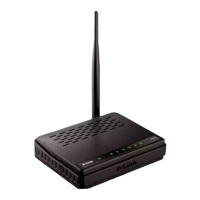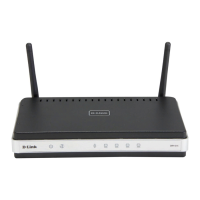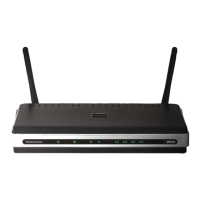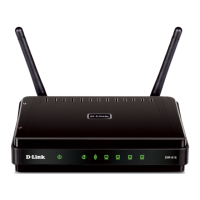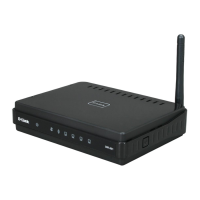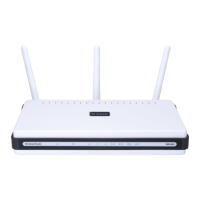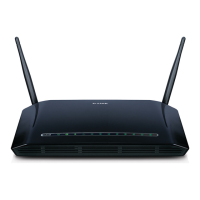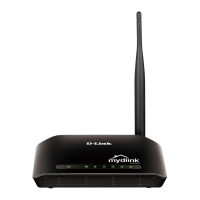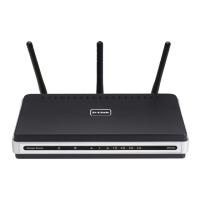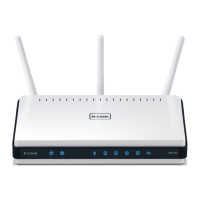Do you have a question about the D-Link DIR-619L and is the answer not in the manual?
Lists the revision history of the manual.
Lists trademarks and copyright information.
Lists items included in the router package.
Specifies hardware and software needed for setup.
Highlights the key capabilities and benefits of the router.
Details the physical components and ports of the router.
Explains how to connect the router to external devices.
Describes the function of each LED indicator on the router.
Provides initial setup considerations and prerequisites.
Offers guidelines for optimal wireless signal placement and performance.
Step-by-step instructions to connect the router to a modem.
How to access the router's configuration interface.
Configures the router's connection to the Internet.
Configures internet connection using static IP details from ISP.
Configures internet connection using dynamic IP from ISP.
Configures internet connection using PPPoE protocol.
Configures internet connection using PPTP protocol.
Configures internet connection using L2TP protocol.
Configures the router's wireless network settings.
Guides user through setting up wireless connection.
Allows manual configuration of wireless settings.
Secures the wireless network using encryption.
Explains the WEP security protocol.
Step-by-step guide to set up WEP encryption.
Explains the WPA security protocol.
Guides user to set up WPA/WPA2-PSK encryption.
Guides user to set up WPA/WPA2-PSK encryption.
Guides user to set up WPA/WPA2 with RADIUS.
Configures the router's local area network settings.
How to set the router's local IP address.
Configures DNS relay functionality.
Manages IP address assignment for network clients.
Enables or disables the DHCP server.
Sets the range of IP addresses for DHCP clients.
Manages the router's internal clock settings.
Selects the time zone for the router.
Configures automatic time synchronization.
Restricts access to websites and online content.
Sets up website filtering rules and access policies.
Defines time-based rules for parental control.
Allows specific ports to be opened for network applications.
Enables or disables a port forwarding rule.
Specifies the internal IP for port forwarding.
Defines the port range for forwarding.
Manages rules for specific network applications.
Specifies ports to trigger application access.
Defines ports for firewall access to applications.
Controls network access based on MAC addresses.
Enables or disables MAC address filtering.
Lists connected clients for MAC address selection.
Manages and prioritizes network bandwidth usage.
Defines rules for controlling bandwidth.
Configures firewall rules and DMZ settings.
Enables SPI (Stateful Packet Inspection) firewall feature.
Enables DMZ host for unrestricted Internet access.
Fine-tunes wireless network parameters.
Selects the wireless operation mode (e.g., mixed, n-only).
Sets the channel width for wireless communication.
Configures advanced LAN settings.
Enables Universal Plug and Play for network compatibility.
Controls router's response to ping requests from WAN.
Defines fixed routes for network traffic.
Specifies the destination IP address for routing.
Manages router login and remote access settings.
Allows remote configuration via the Internet.
Manages router configuration files.
Resets router configuration to factory defaults.
Updates the router's firmware for new features and fixes.
Guides user through the process of updating router firmware.
Configures Dynamic DNS for remote access.
Enables Dynamic DNS service for remote access.
Verifies network connectivity and device status.
Tests network connectivity by pinging IP addresses.
Manages time-based rules for various router features.
Assigns a name to a schedule rule.
Selects the days for the schedule rule.
Configures logging of router events and activities.
Saves the router's log file to the computer.
Configures email settings for sending logs.
Displays current router status and configuration details.
Displays LAN interface information.
Displays WAN interface information.
Displays wireless interface information.
Views a log of router activities and events.
Clears the router's log entries.
Links to the Log Settings configuration page.
Displays network traffic usage data.
Displays traffic statistics for the Internet port.
Displays traffic statistics for the LAN ports.
Shows active network connections.
Displays active NAT sessions.
Lists currently connected wireless clients.
Shows the number of connected wireless clients.
Provides access to support and guidance information.
Instructions for connecting using Windows XP.
Step-by-step guide to set up WEP encryption.
Guides user to set up WPA-PSK encryption.
Guides user to set up WPA/WPA2-PSK encryption.
Guides user to set up WPA/WPA2 with RADIUS.
Steps to initially enable Wi-Fi protection on the router.
Methods to invite new devices to a Wi-Fi protected network.
Accessing computer properties for network settings.
Navigating to advanced system settings for network configuration.
Accessing network adapter properties in Windows Vista.
Selecting the network connection for configuration.
Central hub for network configuration and status.
Initiates the process of setting up network connections.
Accessing network adapter properties.
Managing network connections.
Accessing network adapter properties.
Managing network connections.
Solves issues accessing the router's configuration interface.
Procedure to reset router password via hardware reset.
Troubleshoots connection issues to specific sites or email.
Guides user to adjust MTU settings for improved performance.
Explains what a WLAN is and its components.
Explains wireless technology and its benefits.
Explains the fundamental principles of wireless communication.
Explains WPAN technology and its applications.
Identifies common locations and scenarios for wireless usage.
Explains different wireless networking modes.
Explains the infrastructure mode of wireless networking.
Explains the Ad-Hoc mode of wireless networking.
Steps to find the computer's IP address using cmd.
Manual steps to assign a static IP address to a computer.
Lists the wireless and network standards supported by the router.
Specifies the different wireless data rates supported.
Details the wireless security protocols supported.
Lists advanced firewall functionalities.
Compliance statement with FCC rules for digital devices.
Statement on FCC radiation exposure limits and compliance.
Statement on IC radiation exposure limits and compliance.
Lists the revision history of the manual.
Lists trademarks and copyright information.
Lists items included in the router package.
Specifies hardware and software needed for setup.
Highlights the key capabilities and benefits of the router.
Details the physical components and ports of the router.
Explains how to connect the router to external devices.
Describes the function of each LED indicator on the router.
Provides initial setup considerations and prerequisites.
Offers guidelines for optimal wireless signal placement and performance.
Step-by-step instructions to connect the router to a modem.
How to access the router's configuration interface.
Configures the router's connection to the Internet.
Configures internet connection using static IP details from ISP.
Configures internet connection using dynamic IP from ISP.
Configures internet connection using PPPoE protocol.
Configures internet connection using PPTP protocol.
Configures internet connection using L2TP protocol.
Configures the router's wireless network settings.
Guides user through setting up wireless connection.
Allows manual configuration of wireless settings.
Secures the wireless network using encryption.
Explains the WEP security protocol.
Step-by-step guide to set up WEP encryption.
Explains the WPA security protocol.
Guides user to set up WPA/WPA2-PSK encryption.
Guides user to set up WPA/WPA2-PSK encryption.
Guides user to set up WPA/WPA2 with RADIUS.
Configures the router's local area network settings.
How to set the router's local IP address.
Configures DNS relay functionality.
Manages IP address assignment for network clients.
Enables or disables the DHCP server.
Sets the range of IP addresses for DHCP clients.
Manages the router's internal clock settings.
Selects the time zone for the router.
Configures automatic time synchronization.
Restricts access to websites and online content.
Sets up website filtering rules and access policies.
Defines time-based rules for parental control.
Allows specific ports to be opened for network applications.
Enables or disables a port forwarding rule.
Specifies the internal IP for port forwarding.
Defines the port range for forwarding.
Manages rules for specific network applications.
Specifies ports to trigger application access.
Defines ports for firewall access to applications.
Controls network access based on MAC addresses.
Enables or disables MAC address filtering.
Lists connected clients for MAC address selection.
Manages and prioritizes network bandwidth usage.
Defines rules for controlling bandwidth.
Configures firewall rules and DMZ settings.
Enables SPI (Stateful Packet Inspection) firewall feature.
Enables DMZ host for unrestricted Internet access.
Fine-tunes wireless network parameters.
Selects the wireless operation mode (e.g., mixed, n-only).
Sets the channel width for wireless communication.
Configures advanced LAN settings.
Enables Universal Plug and Play for network compatibility.
Controls router's response to ping requests from WAN.
Defines fixed routes for network traffic.
Specifies the destination IP address for routing.
Manages router login and remote access settings.
Allows remote configuration via the Internet.
Manages router configuration files.
Resets router configuration to factory defaults.
Updates the router's firmware for new features and fixes.
Guides user through the process of updating router firmware.
Configures Dynamic DNS for remote access.
Enables Dynamic DNS service for remote access.
Verifies network connectivity and device status.
Tests network connectivity by pinging IP addresses.
Manages time-based rules for various router features.
Assigns a name to a schedule rule.
Selects the days for the schedule rule.
Configures logging of router events and activities.
Saves the router's log file to the computer.
Configures email settings for sending logs.
Displays current router status and configuration details.
Displays LAN interface information.
Displays WAN interface information.
Displays wireless interface information.
Views a log of router activities and events.
Clears the router's log entries.
Links to the Log Settings configuration page.
Displays network traffic usage data.
Displays traffic statistics for the Internet port.
Displays traffic statistics for the LAN ports.
Shows active network connections.
Displays active NAT sessions.
Lists currently connected wireless clients.
Shows the number of connected wireless clients.
Provides access to support and guidance information.
Instructions for connecting using Windows XP.
Step-by-step guide to set up WEP encryption.
Guides user to set up WPA-PSK encryption.
Guides user to set up WPA/WPA2-PSK encryption.
Guides user to set up WPA/WPA2 with RADIUS.
Steps to initially enable Wi-Fi protection on the router.
Methods to invite new devices to a Wi-Fi protected network.
Accessing computer properties for network settings.
Navigating to advanced system settings for network configuration.
Accessing network adapter properties in Windows Vista.
Selecting the network connection for configuration.
Central hub for network configuration and status.
Initiates the process of setting up network connections.
Accessing network adapter properties.
Managing network connections.
Accessing network adapter properties.
Managing network connections.
Solves issues accessing the router's configuration interface.
Procedure to reset router password via hardware reset.
Troubleshoots connection issues to specific sites or email.
Guides user to adjust MTU settings for improved performance.
Explains what a WLAN is and its components.
Explains wireless technology and its benefits.
Explains the fundamental principles of wireless communication.
Explains WPAN technology and its applications.
Identifies common locations and scenarios for wireless usage.
Explains different wireless networking modes.
Explains the infrastructure mode of wireless networking.
Explains the Ad-Hoc mode of wireless networking.
Steps to find the computer's IP address using cmd.
Manual steps to assign a static IP address to a computer.
Lists the wireless and network standards supported by the router.
Specifies the different wireless data rates supported.
Details the wireless security protocols supported.
Lists advanced firewall functionalities.
Compliance statement with FCC rules for digital devices.
Statement on FCC radiation exposure limits and compliance.
Statement on IC radiation exposure limits and compliance.
| Frequency Band | 2.4 GHz |
|---|---|
| LAN Ports | 4 x 10/100 Mbps |
| WAN Ports | 1 x 10/100 Mbps |
| Wireless Speed | Up to 300 Mbps |
| Operating Humidity | 10% to 90% non-condensing |
| Storage Humidity | 5% to 95% non-condensing |
| Wireless Standard | IEEE 802.11b/g/n |
| Security | WPA, WPA2 |
| Operating Temperature | 0 to 40 °C |
| Storage Temperature | -20 to 65 °C |
| Antenna Type | 3 x 5dBi External Antennas |
